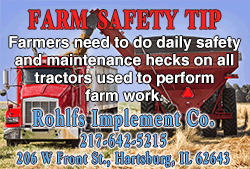|
 While essential to Illinois’ harvests, grain handling equipment
and storage containers can quickly become deadly. In fact,
Illinois reported the most incidents involving agricultural
confined spaces, including grain bins, in 2020. Illinois also
had the most grain-entrapment cases – 10 – in 2020, as
documented by the University of Purdue’s Agricultural Safety and
Health Program. While essential to Illinois’ harvests, grain handling equipment
and storage containers can quickly become deadly. In fact,
Illinois reported the most incidents involving agricultural
confined spaces, including grain bins, in 2020. Illinois also
had the most grain-entrapment cases – 10 – in 2020, as
documented by the University of Purdue’s Agricultural Safety and
Health Program.
While the report says these numbers may be attributable to
greater efforts to bring attention to these incidents, the total
number of cases may have been underreported due to inadequate
reporting structures.
“It’s crucial for farmers and other agricultural workers to put
safety first during harvest season. Carelessness can cause
injury or death. First responders must also be properly trained
on the procedures for safely rescuing a worker from a grain
bin,” said Illinois Department of Labor Director Michael Kleinik.

“Harvest is often a time where our farmers are up against a
clock and rush through ordinary tasks like going in and out of
grain bins. People often think they are big enough, strong
enough, or fast enough to get out of flowing grain.
Unfortunately, problems can snowball quickly,” said Illinois
Department of Agriculture Director, Jerry Costello II.
Because moving grain acts similarly to quicksand, tragedy can
strike in seconds. The U.S. Occupational Safety and Health
Administration (OSHA) says a worker standing in moving grain
will be trapped within five seconds and covered by grain in less
than 30 seconds.
“There are three things you need to emphasize: don’t go into
bins alone; number two is turn off anything that can make the
grain move, so we can keep it static; and lock out, tag out,”
said Dave Newcomb, the Agriculture Program Manager with the
Illinois Fire Service.
According to OSHA, the most common situations leading to grain
entrapment include:
-
A worker standing on moving/flowing grain typically caused
by a running auger or grain being moved out of the bin by
gravity.
-
A worker stands on or below a grain bridging situation.
Bridging happens when damp grain clumps together, creating
an empty space beneath the grain as it is unloaded. A worker
above or below this bridge of grain is at risk should the
bridge collapse.
-
A worker stands next to a pile of grain on the side of the
bin and attempts to dislodge it. It can collapse onto the
worker.
[to top of second column] |

While workers should avoid entering grain bins – if possible –
safety measures can greatly reduce the risk if they must enter.
One of the most important measures is to turn off and lock out
all powered equipment to the grain bin and tag it to remain off
– known as Lock Out/Tag Out – so the grain is not being emptied
or moving out or into the bin. The following can also be done to
reduce the risk in grain bins:
-
Prohibit walking on or down grain to make it flow.
-
Provide all employees a body harness with a lifeline, or a
boatswain’s chair, and ensure it’s secured prior to the employee
entering the bin.
-
Provide an observer outside the bin or silo being entered by an
employee. Ensure the observer is equipped to help and their only
task is to continuously track the employee in the bin. Prohibit
workers from entry into bins or silos underneath a bridging
condition, or where a build-up of grain products on the sides
could fall and bury them.
-
Train all workers for the specific hazardous work operations
they are to perform when entering and working inside of grain
bins.
-
Test the air within a bin or silo prior to entry for the
presence of combustible and toxic gases, and to determine if
there’s sufficient oxygen.

-
If
detected by testing, vent the silo or grain bin to ensure
combustible and toxic gas levels are reduced to non-hazardous
levels, and sufficient oxygen levels are maintained.
-
Ensure a permit is issued for each instance a worker enters a
bin or silo, certifying the precautions listed above have been
implemented.
OSHA notes that more than half of deaths in grain entrapment
cases are would-be rescuers and about seven in 10 occur on
family farms.
OSHA has more information about grain bin safety online:
Grain Handling
Safety
[Illinois Office of Communication and
Information] |